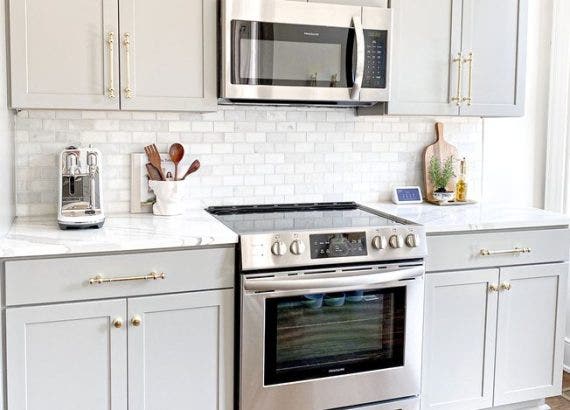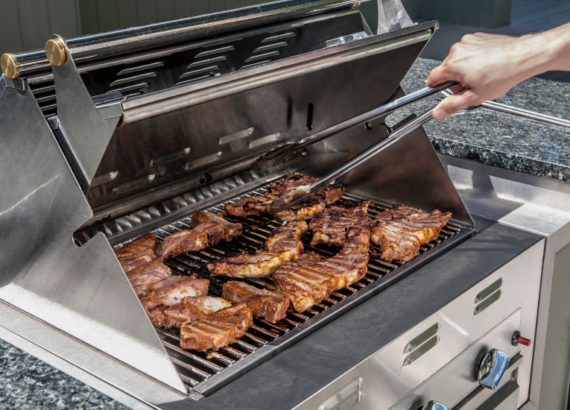How do you know if a microwave is leaking radiation?

The microwave is one of the most popular appliances in today’s kitchens.
Have you ever wondered: How do you know if a microwave is leaking radiation?
In short, homeowners don’t need to worry about this. Injuries from microwave radiation are exceedingly rare. The FDA has restrictions in place to ensure consumer safety.
But maybe you suspect something is wrong with your microwave and want to test it. Luckily it’s pretty easy.
Table of Contents
Radiation Detector
The simplest way to determine if your microwave is leaking radiation is to use a microwave radiation detector like this one. Make sure that the radiation detector detects high-frequency signals from microwave ovens. Check the product description and reviews before making a purchase. Microwave radiation detectors cost anywhere between $20 and $200 so if you want to save money, the cell phone method is best.
Cell Phone
If you have WiFi that operates on a 2.4 Gigahertz (GHz) band, then you can use your cell phone to determine if a microwave is leaking radiation.
Your microwave should read 5 milliwatts (mW) or less at a distance of about two inches from the microwave, according to the FDA.
Note: A phone with data enabled will ring in the microwave; the door won’t block the signal. So make sure your cellular data is turned off (and WiFi is on). Cellular data transmits and receives signals between 800 and 1900 Megahertz (MHz). Microwaves emit a 2.4 GHz signal, which is much higher. WiFi matches this higher frequency.
So why do frequencies differ between mobile phones and microwaves? Well, your microwave is much larger than your phone. It needs enough power to heat food quickly.
In the video below, the microwave is tested using a phone with cellular data off. It turns out that the cell phone rings. That’s not good! It was later discovered that the microwave leaks some radiation.
1. Unplug your microwave.
You wouldn’t want to accidentally microwave your phone. All you need to do is put it inside and call it.
2. Turn cellular data off and WiFi on.
Cellular data transmits and receives signals at a much lower frequency compared to WiFi and microwaves. If you leave data on, the test won’t work properly. Your phone will always ring.
So you need to have WiFi enabled since most WiFi networks operate at 2.4 GHz, equal to a microwave.
If you turn off cellular data, you can use WiFi to make WiFi calls.
3. Check that your WiFi network is 2.4 GHz.
WiFi operates on either a 2.4 GHz or 5 GHz band. Microwaves also operate at 2.4 GHz. Check your WiFi settings to make sure that your network is 2.4 GHz.
On a Mac, you can hold the option key and click the WiFi icon to see network properties. On Windows, you can click the WiFi icon in the bottom right of your monitor, open the Networks panel, and click on Properties.
Many new phones are 5 GHz compatible. 5 GHz networks can be reverted to 2.4GHz in your WiFi settings if necessary. On most devices, you can change your “preferred band” to 2.4 GHz in the settings.
Note: A band is a common term in telecommunication used to describe a range of frequencies.
4. Put one of the phones inside the microwave and close the door.

Make sure you put the phone in the microwave with the appropriate settings. Cellular data should be off and the WiFi network should be 2.4 GHz.
5. Call the phone inside the microwave.
If you hear no ring, your microwave is not leaking radiation. If you hear a ring, your microwave is leaking radiation, assuming the settings on your phone are correct.
It’s highly unlikely that your leaking microwave is a danger to your health. All microwaves are FDA approved and emit tiny amounts of radiation.
If your phone rings, the seal on the door or the door interlocking mechanism might be broken. In this case, replace your microwave. The repair is most likely not worth the cost.
Remember, when changing settings on your phone, it’s easy to make a mistake. Be sure to double check your settings before completing this test.
Hopefully this test worked for you. If you’re having trouble, ask a friend for help. Maybe try the test on their microwave.
Don’t stress too much over microwave radiation. In short, if your microwave is not functioning properly, consider replacing it. Thanks for reading!

Related Articles
Can you put a paper towel in the microwave?
5 Places to Put Your Microwave (Not Over the Stove)
How do you know if a microwave is leaking radiation?
The simplest way to determine if your microwave is leaking radiation is to use a microwave radiation detector like this one. Make sure that the radiation detector detects high-frequency signals from microwave ovens. Check the product description and reviews before making a purchase. Microwave radiation detectors cost anywhere between $20 and $200 so if you want to save money, the cell phone method is best.







Comments are closed.